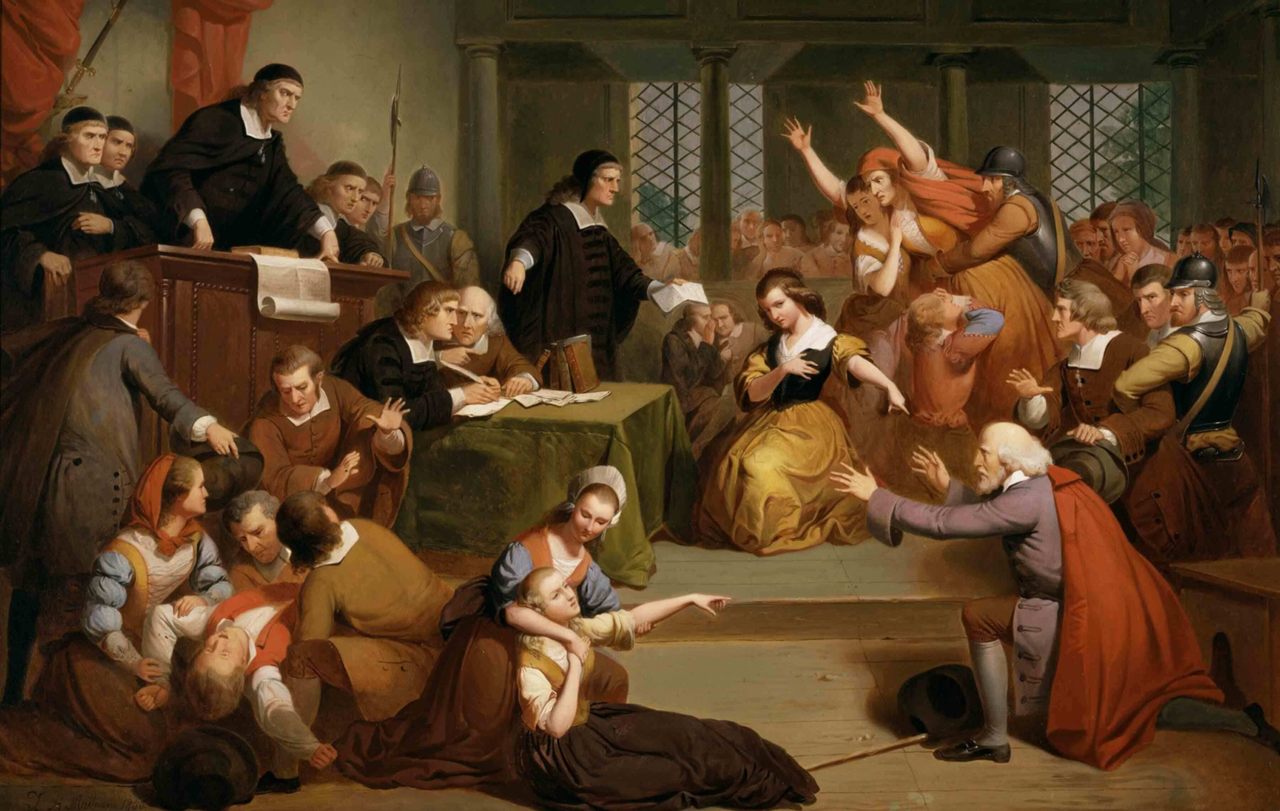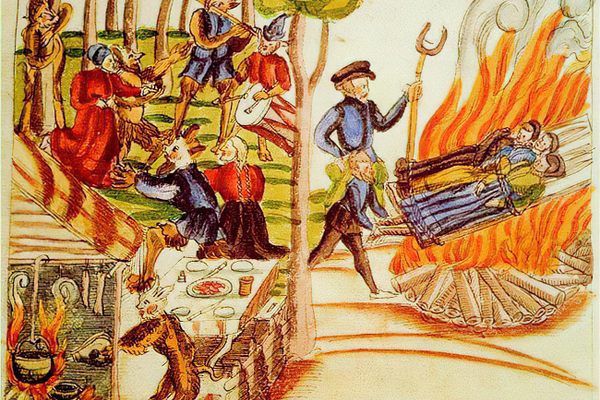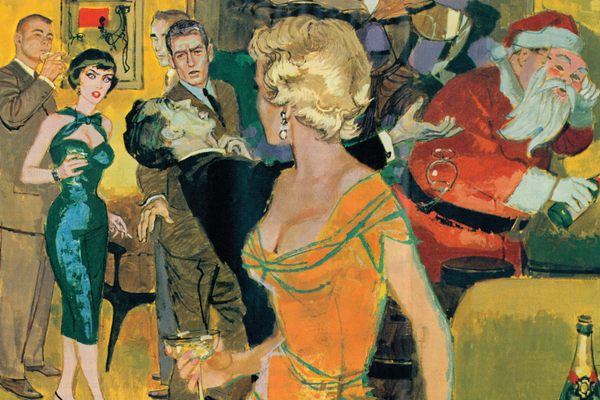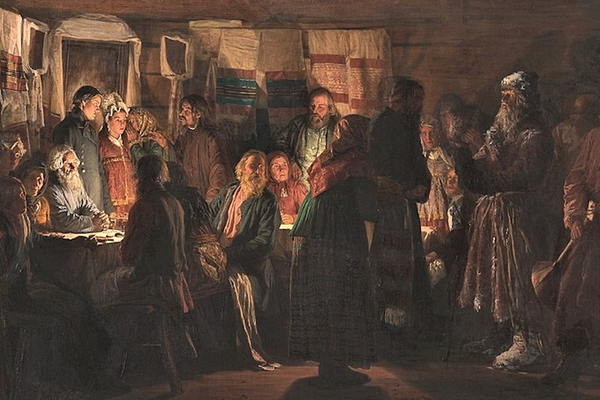The Salem Witch Trials Actually Happened in Danvers, Massachusetts
Tensions between Salem and Danvers were there from the start—contributing to the ensuing witch hysteria.
On a crisp late April morning in 1692, Benjamin Hutchinson was on his way to a local tavern in the quiet New England farming community of Salem Village, Massachusetts, when he was stopped by 11-year-old Abigail Williams. Frantically, Williams gestured to a “little black” figure in the form of the area’s former local reverend, George Burroughs. Hutchinson could not see the specter, but trusted Williams—a “visionary girl” who’d already identified several witchcraft suspects tormenting local girls. Without hesitation, Hutchinson thrust his pitchfork toward his invisible enemy. Hutchinson would later testify that the villain’s coat had torn under the metal prongs.
Over 300 years later, that tavern, Ingersoll’s Ordinary, still stands along with a handful of other buildings that became the backdrop for colonial America’s most infamous witch hunt: the Salem witch trials. There’s just one thing—these buildings aren’t in Salem, Massachusetts. At least, not anymore.
In 1692, there were two Salems: the bustling seaport, Salem Town, and the rural farming community, Salem Village. Salem Village remained a rural precinct of greater Salem until January 28, 1752, when it was renamed Danvers, Massachusetts. But it was here, in sleepy 17th-century Salem Village, that Abigail Williams and other ailing adolescent girls were first declared bewitched, a completely legitimate diagnosis in 1692, prompting witchcraft accusations to fly.
Today, Salem, Massachusetts, (the former Salem Town) has become a Halloween mecca, attracting 100,000 daily tourists in October who visit Hocus Pocus filming sites and a sculpture honoring the 1960s sitcom Bewitched. While modern Salem capitalizes on costumed October crowds, Danvers avoids the limelight and feels like any sleepy New England neighborhood. How could these once-intertwined communities bear hardly a resemblance now? Well, the two Salems were at odds from the start.

The Beginnings of Salem Village
In 1640, a group of farmers migrated west and north, away from Salem Town’s thriving seaport and wealthy merchants in search of arable lands. This new rural settlement became Salem Village, and was still part of greater Salem.
The villagers sought their independence early on, but the Salem Town magistrates refused to reduce the town’s land holdings or tax base. The village remained stubborn, objecting to traveling the five difficult miles required to attend church or military watch (both requirements of these early Puritan communities).
Villagers especially resented the compulsory military service. Precariously situated on the frontier, Salem Village faced many threats, including potential attacks from Native American and French forces. Many villagers did not understand why the larger Salem Town wasn’t instead sending militia to protect them.
Stacy Schiff, author of The Witches: Salem, 1692, noted via email, “The town and village repeatedly annoyed each other. The village because the town adjudicated on its behalf. The town because the villagers seemed a quarrelsome lot, who over and over appealed to the town to resolve their disputes.”
One of the longest-spanning disputes was the generational feud between Salem Village’s Putnam and Towne families, where Salem Town had to repeatedly step in to solve what were, in their minds, petty matters of inheritance and land disputes. “At one point,” Schiff continued, “a justice from Salem Town essentially asked that the villagers keep their antipathies to themselves.”
The weary Salem Town magistrates eventually loosened their hold on the village, granting Salem Village its own parish in 1672. In 1689, Samuel Parris became the village’s first ordained minister.

The Salem Witch Trials of 1692
These unresolved frustrations festered beneath the surface when suddenly both Salems were facing a common threat: The Devil was recruiting local witches to topple their hard-won Puritan society. In mid-January 1692, Reverend Parris’s daughter Betty became the first girl to suffer at the Devil’s hands. Under the watchful eye of her cousin Abigail Williams, who was living with the Parris family, Betty would make animal noises, start babbling indecipherably, and go limp while staring into space.
As more girls became afflicted, including Williams, witchcraft accusations began to fly. Initially, the most vulnerable individuals in the village were accused: Tituba, an enslaved Native American woman, the homeless Sarah Good, and society outcast Sarah Osborne. The first accused to be executed was the most convenient: Bridget Bishop, who had been tried for witchcraft decades earlier in 1680.
But as the trials heated up, even respected community members headed to the gallows, such as 71-year-old Rebecca Nurse. The well-off Nurse family had moved from Salem Town to Salem Village in 1678, maintaining a prosperous farm and raising eight children to adulthood in the village. Rebecca Nurse’s accuser, 12-year-old Ann Putnam, on the other hand, had been born and raised in Salem Village and had lost many siblings.
Nurse, a member of the Towne family, and the Putnams had long been at odds. By 1692, the Putnams had lost “out on some inheritance and they weren’t doing that well financially,” says Kathryn Rutkowski, curator and docent of the Rebecca Nurse Homestead. Perhaps, she says, they looked at the Nurses and thought, “How come they are thriving? How come we’re being punished?”
It’s impossible to know if young Ann Putnam was aware of the families’ feuding, but she likely understood that the Nurses had more when she had less. And, in part, the Nurses had more because they had come from prosperous Salem Town.

Incensed at Nurse’s conviction, 39 individuals signed a petition advocating for the elderly woman’s acquittal. Signers included Joseph Hutchinson, Daniel Andrews, Francis Nurse (Rebecca’s husband), and Joseph Putman (young Ann’s half-uncle), all of whom had ties to Salem Town, whether through business or family connections. Joseph Putnam’s mother was the widow of a wealthy Salem Town mariner. Andrews owned land in both Salem Town and Salem Village and was elected Salem Town selectman shortly before being accused of witchcraft himself.
Sadly, Nurse’s petition was not enough to exonerate her, and she was executed in Salem Town in July 1692.
While Nurse’s Salem Town connections didn’t save her from the gallows, they did for many others. Accused individuals with ties to Salem Town largely avoided execution, mainly because their wealth enabled them to avoid arrest.
Salem Town landowner Daniel Andrews could afford to leave town after learning of his accusation. The wealthiest of the accused, such as Philip and Mary English of Salem Town, evaded arrest by paying a £4,000 bond and fleeing Massachusetts. Ultimately, far more Salem Village residents (eight total) were executed than Salem Town residents during the trials (only three).
After the Witch Trials: Welcome to Danvers
By September of 1692, the peak of the witch hysteria was over and 25 innocent people were dead. 19 people were hanged. Five people had died in prison, and one elderly man was pressed to death. The vast majority of those executed came from rural areas: the majority from Salem Village.
After the trials, “in both Salem and Danvers, there was shame over what had happened here and a reluctance to deal with the trauma of the trials,” says Dan Lipcan, a library director and curator of the Peabody Essex Museum in Salem, Massachusetts.
Slowly, Salem Village—the epicenter of the hysteria—began to move on, building a new meeting house in 1701 and abandoning the bad memories of the former. In 1706, Ann Putnam made a public apology, stating, “As I was a chief instrument of accusing Goodwife Nurse and her two sisters, I desire to lie in the dust and to be humbled for it.”

Many of the other young girls who levied accusations married and moved away. Abigail Williams, who made numerous witchcraft accusations, disappeared from official records after June 1692, offered no known apology and is believed to have died in 1697.. The village gained its long-sought independence in 1752, adopting the name Danvers to avoid confusion with Salem Town.
Salem Town, which now just goes by Salem, had a harder time forgetting its role in the witch trials. Locally-born Nathaniel Hawthorne was among the first to cultivate an air of mystery around the city with his best-selling novels The Scarlet Letter and The House of Seven Gables. This continued into the 20th century with works such as Arthur Miller’s The Crucible and the popular sitcom Bewitched filming several episodes in the city in 1970.
Leading up to Salem Town’s bicentennial in 1892, local businesses began issuing tourist guides that mentioned key witch trial sites and selling souvenirs like “witch creams” and the popular “witches spoons.”
Then, in 1914, a devastating fire destroyed a third of Salem’s buildings, leaving thousands unemployed, and gutting the town’s manufacturing industry. “Salem kind of needed something to prop up the economy,” says Lipcan. “With the rise of the Halloween industry, Haunted Happenings [an annual, month-long October series of events] started in Salem in the early ’80s,” he says. “The witch economy is kind of the basis of the tourism industry here.”
Five miles away, Danvers doesn’t have a single witch trinket for sale and is more sleepy, Boston suburb than witch-themed tourist attraction. Danvers never faced the same economic motivation to capitalize on its witch trial history and remained obscured from the public eye.
“It helped that Danvers could hide behind its new name,” explained Schiff via email. Today, Danvers has ten buildings still standing connected to the trials, among them Ingersoll’s Ordinary.
More than 300 years after the Salem witch trials, the cream-colored tavern remains, nestled between residential homes on Danvers’s quiet Hobart Street—an easily overlooked reminder of where the witch hysteria really took hold, miles away from the costumes and souvenirs of nearby Salem.


















Follow us on Twitter to get the latest on the world's hidden wonders.
Like us on Facebook to get the latest on the world's hidden wonders.
Follow us on Twitter Like us on Facebook